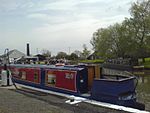Woodseaves
Borough of StaffordVillages in Staffordshire

Woodseaves is a village in Staffordshire, England. It lies in the civil parish of High Offley and is situated on the A519 (Newport-Newcastle-under-Lyme) road and lies at the south-west end of the B5405 road, which leads to Great Bridgeford. Nearby are the villages of Gnosall and Norbury, the hamlets of Knightley and High Offley, and the small town of Eccleshall. The elevation of the village is between 125 metres (410 ft) and 140 metres (460 ft) above sea level. The centre of the village is the top of a small hill, relative to the adjacent countryside, and the roads into and out of the village are almost all sloping away from the village.
Excerpt from the Wikipedia article Woodseaves (License: CC BY-SA 3.0, Authors, Images).Woodseaves
Am Kirchhof,
Geographical coordinates (GPS) Address Website Nearby Places Show on map
Geographical coordinates (GPS)
| Latitude | Longitude |
|---|---|
| N 52.8266 ° | E -2.3008 ° |
Address
St. Martini Kirche
Am Kirchhof
31655
Niedersachsen, Deutschland
Open on Google Maps






